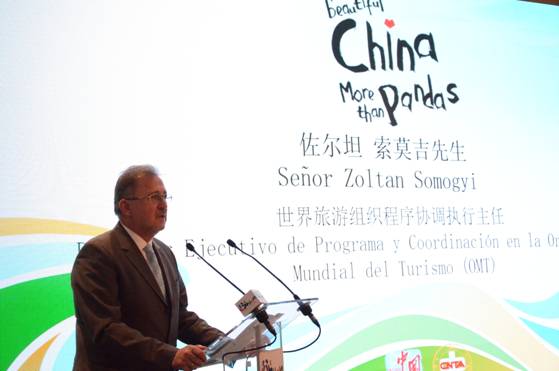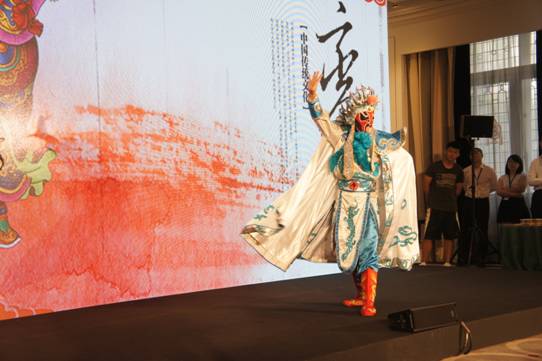
Sichuan promotes tourism in Madrid

“Beautiful China, more than pandas,” a large-scale overseas tourism marketing campaign by Sichuan, was carried out in Barcelona on June 15 local time.
About 200 people representing Spain’s tourism industry, overseas Chinese organizations in Spain as well as media organizations attended the marketing event.
People dressed like giant pandas staged a flash mob as a prelude to the event.

Sichuan is the home town of giant panda, has the largest economy in west China, ranks high among Chinese provinces for tourism resources, and has a distinctive culture.
The province’s position at the junction of the Silk Road Economic Belt and the Yangtze River Economic Belt also gives it a competitive edge, making it a frontier in the opening-up of west China.
Gan Lin, Sichuan’s Publicity Department, repeated in his address Sichuan’s goal to become a national leader in terms of tourism development and build itself into a major international tourist destination.

Spain, as a world-famous tourist destination, has a great deal of experience in the planning, building, management, marketing and personnel training of tourist destinations.
Gan said that Sichuan and Spain are complementary in developing tourism, hoping more exchanges and cooperation will result from the promotional event in Madrid.
Zoltan Somogyi, Director for Programme and Coordination at the World Tourism Organization, shared his personal experience of travelling to Sichuan, naming culture and history, natural landscape and giant panda as the symbols of Sichuan.

Fu Yonglin, Director of Sichuan Provincial Tourism Development Committee, gave a presentation about Sichuan’s tourism resources.
Chengdu, capital of Sichuan, has both a vibrant economy and abundant tourism resources. The city’s Shuangliu International Airport is the fourth largest in China, with 101 international and regional routes and direct flights to 78 cities. The city’s second airport, Tianfu International Airport, is expected to be operational by 2020, making Chengdu the third Chinese city to have two international airports.
Sichuan has actively engaged in international cultural and economic exchanges. The province has economic and trade ties with 232 countries and regions, 16 countries have set up consulates in Sichuan and 321 of the world’s top 500 companies have operations there. 1,000 Chengdu-Europe Cargo Express trains will run in 2017. Sichuan also offers 72-hour visa-free entry for transit passengers of 51 countries across the world.
Chengdu Municipal Government, the Comunidad de Madrid Government and the Madrid City Government jointly hosted the 2017 Spain-Chengdu Week in January, which had seen over 5,000 Spanish tourists visiting Sichuan and over 58,000 Sichuan tourists visiting Spain as of June.
David Berna, the Comunidad de Madrid Government official overseeing cultural affairs, spoke highly of Sichuan’s impressive tourism resources such as a long history, the unique natural landscape and the delicious food, encouraging more Spanish people to visit Sichuan.
China and Spain are carrying out all-round, multi-layer cooperation, according to Zhang Zhiyun, head of the Madrid Office of China National Tourism Administration.
Zhang gave an introduction to Spain’s tourism industry, especially its successful growth pattern, calling on Chinese tourism industry to learn from and cooperate with their Spanish counterpart.
Sichuan International Business Travel Service, Chengdu Cultural Tourism Marketing Company, Sichuan China Travel Service signed cooperative agreements with three Spanish travel services respectively, in the belief that the agreements will generate more two-way tourist arrivals between China and Spain.
A representative of Sichuan Travel Service gave a presentation about Sichuan’s tourism products and its delicious food.
Ricardo Blanco Sánchez, a Spanish and one of the fans recruited under the program "Travel the Southern Silk Road, Visit the Homeland of Panda-European Panda Fans Travel to Sichuan," shared his experience visiting Sichuan.

Face-changing performance of Sichuan Opera and tea-making skills, both distinctive Sichuan cultural elements, were shown during the promotional event.

On the afternoon that same day, Gan and his delegation visited the World Tourism Organization, where they discussed the preparation work for the WTO 22nd Congress due to be held in Chengdu in September with WTO’s general secretary. The two parties also made in-depth exchanges on how to design products, generate two-day tourist arrivals and carry out joint marketing under the Belt and Road Initiative.
One day earlier, the publicity department of Sichuan government and the cultural bureau of Madrid jointly held an exhibition of the ancient civilization of the State of Shu from Sichuan, China in a park in Madrid.
















